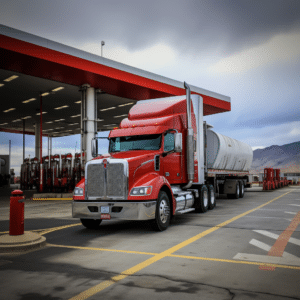Understanding Big Rigs: Exactly How Many Axles Does an 18 Wheeler Have?
Last updated Thursday, October 31st, 2024

Have you ever found yourself driving alongside an 18 wheeler and wondered, “how many axles does an 18 wheeler have?” Axles are a crucial component in the structure and performance of these massive vehicles. Understanding their configuration, function, and impact on vehicle performance can provide valuable insights into the world of large trucks and help ensure their safe operation.
Axles Explained: The Basics of an 18 Wheeler’s Axle Configuration
In the world of big rigs, axles hold a significant position in the overall structure and operation of the vehicle. An 18 wheeler typically consists of three principal types of axles:
- Steering axles: These offer crucial control and maneuverability.
- Rear axles: These provide support for the trailer and power for propulsion.
- Lift axles: These serve as supplementary axles that can be activated to enhance stability and distribute weight more evenly.
Each type of axle serves a distinct purpose in the functionality of the truck.
Grasping the axle configurations is imperative for truck drivers, fleet operators, and others who share the road with these large vehicles. Below, we will go deeper into the role of each axle type and examine their impact on truck performance, safety, and maintenance.
Steering Axle
The steering axle is located at the front of the truck and is responsible for:
- Directing and controlling the movement of the vehicle
- Providing precise control
- Allowing the front wheels to steer and direct the vehicle
- Making it easier for the truck driver to navigate turns and maneuver in tight spaces
It plays a pivotal role in the maneuverability of an 18 wheeler.
Constructed from special quenched and tempered alloy steel for durability and strength, the steering axle comprises of drag links and steering gears, which help control the rear wheel movement. The steering axle functions by receiving input from the driver via the steering wheel, which is then transmitted to the front wheels via components such as tie rods and drag links. The tie rods regulate the simultaneous movement of the front wheels, allowing them to turn in the desired direction, and ensuring proper control and maneuverability.
Rear Axles
Rear axles are found at the back of the truck and serve to offer support for the trailer and supply power for propulsion. They provide a critical function in the overall operation of an 18 wheeler by bearing the weight of the trailer and its cargo, thereby distributing the weight evenly across the axles to ensure stability and balance while the truck is in motion. Additionally, rear axles help absorb shocks and vibrations from the road, providing a smoother ride for the trailer.
Rear axles contribute to propulsion by supplying traction and transmitting engine power to the wheel axles, thus enabling the truck to move in a forward or backward direction. The construction design of rear axles in tractor trailer trucks, such as 18 wheelers, may differ depending on the specific model and manufacturer. However, popular designs include tandem axles and lift axles.
Lift Axles
Lift axles are additional axles that can be raised or lowered to distribute weight and improve stability. They are often found on vehicles like concrete mixer trucks, tanker-style trucks, and dump trucks. Lift axles operate utilizing a raising and lowering mechanism, allowing the axle to be raised or lowered depending on the load it is carrying, ensuring optimal weight distribution and improved maneuverability.
The mechanical components of a lift axle include:
- Steerable components that help prevent damage to chassis components, tires, and wheels caused by scrubbing or dragging
- Additional support and weight distribution, enabling the transportation of heavier loads without detrimentally affecting the truck and trailer when they are not loaded
- Augmentation of roll stability during low-speed turns
These features make lift axles an important tool for trucking companies looking to optimize their load capacity and maintain the integrity of their vehicles.
The Typical Axle Count for an 18 Wheeler
An 18 wheeler usually boasts five axles, composed of one steering axle, two rear axles on the tractor, and two axles on the trailer. This axle count plays a significant role in determining the load capacity of the truck, with an increase in axles generally allowing for a higher weight capacity. However, it’s significant to account for the weight distribution and guarantee proper loading to sustain balance and stability.
Federal regulations and other factors, such as the type of cargo and trailer configuration, influence the number of axles a truck can have. Below, we will go into these factors in more detail and discuss their influence on the typical axle count for an 18 wheeler.
Federal Regulations and Axle Limits

- Single Axle: 20,000 lbs
- Double Axle: 34,000 lbs
- Tridem Axle: 42,000 lbs
- Gross Weight: 80,000 lbs
The Federal Motor Carrier Safety Administration (FMCSA) calculates the allowable weight for trucks in accordance with federal regulations, which include a maximum gross vehicle weight limit of 80,000 pounds, and individual axle load limits that must be adhered to. These regulations are in place to ensure the safe operation of commercial vehicles and to prevent damage to roads and infrastructure.
Factors Affecting Axle Count
Several factors can influence the axle count of an 18 wheeler, including the kind of cargo being transported, the trailer configuration, and regulations specific to each state. For example, cargo types necessitating more axle counts on 18 wheelers include seven or more axle multi-trailer trucks, freight or bulk trucks carrying heavy loads, and flatbed trailers carrying heavy cargo. In addition, the trailer configuration can have an effect on the axle count, as different configurations such as tandems or tri-axles can influence factors like load capacity, maneuverability, and compliance with weight regulations.
The terrain and route can also have an impact on the axle count of 18 wheelers. The gradient of hills along the route and the weight of the truck can determine the amount of torque required, which may necessitate additional axles for enhanced traction and steadiness. Furthermore, rugged terrain may require trucks to have more axles to evenly distribute the weight and provide improved suspension.
How Axles Impact Vehicle Performance
Axles play a significant role in vehicle performance, including weight distribution, fuel efficiency, and braking and handling. A proper axle configuration ensures that the weight of the vehicle is evenly distributed across the axles, providing stability and balance while the truck is in motion. Moreover, the number of axles can impact fuel efficiency, with more axles potentially leading to increased fuel consumption. Lastly, the number and placement of axles affect braking and handling, as more axles provide better control and stopping power.
In the subsequent sections, we will examine these aspects of vehicle performance in greater detail, discussing how:
- Axle count and configuration can influence weight distribution and stability
- Fuel efficiency can be affected by various factors
- Braking and handling can be improved through certain mechanisms
Weight Distribution and Stability
Correct axle configuration is crucial for maintaining even weight distribution and stability in 18 wheelers, as it directly impacts the truck’s ability to carry heavy loads and keep balance during transport. An uneven weight distribution can have a detrimental effect on the truck’s stability, increasing the likelihood of rollover accidents, particularly when the trailer is not evenly loaded and the weight distribution is off. Running with an excessive amount of weight on one end can detrimentally affect the vehicle’s dynamic stability and braking performance, making it crucial to guarantee appropriate weight distribution for the safe operation of an 18 wheeler.
Adopting a proper axle configuration can help to reduce the risk of truck accidents by:
- Improving weight distribution and stability
- Enhancing the truck’s ability to maneuver on the road
- Diminishing the prospect of rollovers or loss of control
This is especially important when considering the sheer size and weight of these vehicles, as well as the potential consequences of a truck accident involving large trucks, passenger cars, and passenger vehicles, which is why obtaining a commercial driver’s license is crucial.
Fuel Efficiency

- More axles can result in increased fuel usage due to the extra weight and friction on the road.
- The weight distribution of axles also has a substantial effect on fuel consumption.
- Every additional pound of weight necessitates the engine to exert more effort, resulting in a reduction in fuel economy.
Consequently, accurate weight distribution is vital for optimizing fuel efficiency.
The most fuel-efficient axle configurations for semi trucks include a 6×2 single drive axle setup and 6×4 models with an improved rear-axle configuration. These setups can help to reduce driveline friction and enhance fuel economy, making them a more environmentally friendly and cost-effective choice for long-haul transportation.
Braking and Handling
The quantity and positioning of axles significantly influence the braking and handling of an 18 wheeler, as they can affect the truck’s stability and its ability to brake and maneuver effectively. Axles that are not adequately maintained can cause instability, which can raise the probability of an accident occurring. Moreover, axle failures in trucks can result in jack-knife accidents due to a lack of control and stability, as the failure can cause uneven braking or a decrease in traction, leading to the trailer swinging out to the side and forming a V-shape with the rest of the truck.
To prevent such accidents and ensure optimal performance, it’s crucial to keep the axles in good condition and adhere to safety protocols, such as regular inspections and servicing, correct weight distribution, and compliance with federal regulations. By doing so, truck drivers can minimize the likelihood of accidents and guarantee a smooth and safe journey on the road.
Axle Configurations in Different Types of Semi Trucks
Different types of semi trucks have varying axle configurations, with semi trailer trucks typically having fewer axles than double or triple trailer trucks. The axle configurations in these trucks are designed to optimize factors such as:
- Load capacity
- Maneuverability
- Adherence to weight regulations
- Suitability for particular applications
Below, we will examine the axle configurations of single trailer trucks, as well as double and triple trailer trucks, and discuss their effect on truck performance and safety.
Single Trailer Trucks
Single trailer trucks, also known as tractor trailers, usually have five axles, with one steering axle, two rear axles on the tractor, and two axles on the trailer. These axle configurations contribute to the stability and handling of single trailer trucks by providing support and distributing the weight of the load. Tandem axles, which are commonly employed in single trailer trucks, offer more stability than a single-axle trailer, as they are capable of bearing more weight, rendering them suitable for hauling heavier items.
Appropriate axle configuration in single trailer trucks not only guarantees stability and handling but also significantly contributes to accident prevention. As mentioned earlier, proper weight distribution and axle maintenance are essential for preventing accidents involving large trucks and ensuring the safe operation of these vehicles on the road.
Double and Triple Trailer Trucks
Double and triple new trailer rigs have more axles to support the additional weight and length of the extra trailers. A common axle configuration for double trailer trucks is a 6×4 setup, wherein both rear tandem axles are powered. In contrast, triple trailer trucks typically possess three axles, with a common configuration including a tandem axle with an air-lifted third axle, allowing truck drivers to adjust the lift as required.
The added axles in these types of trucks provide stability and support to the vehicle and enable it to carry heavier items and multiple trailers. However, they can also present challenges in terms of maneuverability and safety, as more axles can potentially lead to increased fuel consumption and greater difficulty in controlling the vehicle. Therefore, proper axle configuration and maintenance are crucial for ensuring the safe and efficient operation of double and triple trailer trucks.
Axle Maintenance and Safety Considerations
Correct axle maintenance and safety considerations are crucial to avoid accidents and ensure optimal performance in 18 wheelers. Regular inspections, servicing, and adherence to federal regulations are crucial aspects of axle maintenance that can help to identify and address common axle issues, such as wear and tear, misalignment, and damage. By maintaining axles in good condition and following proper safety protocols, truck drivers can minimize the likelihood of accidents and guarantee a smooth and safe journey on the road.
Below, we will discuss:
- Common axle issues and their solutions
- The role of axles in truck accidents
- The importance of adhering to safety protocols to ensure a secure and efficient driving experience.
Common Axle Issues and How to Address Them
Common axle issues, such as wear and tear, misalignment, and damage, can negatively impact the performance and safety of 18 wheelers. Signs of axle wear and tear in 18 wheelers may include excessive vibrations, peculiar noises, and irregular tire wear. To address these issues, it is essential to carry out regular inspections and maintenance, such as checking fluid levels, cleaning internal components, and monitoring the tightness of lug nuts on the wheels.
By identifying and addressing these common axle issues, truck drivers can ensure the safe and efficient operation of their vehicles. Proper axle maintenance not only helps to prevent accidents but also prolongs the life of the truck and its components, ultimately saving time and money in the long run.
The Role of Axles in Truck Accidents
Axles hold significant weight in truck accidents, with improper axle configuration or lack of maintenance potentially leading to loss of control, jack-knife accidents, or rollovers. An imbalance in the weight distribution across the axles can have an effect on the stability and handling of the truck, thereby raising the likelihood of accidents. Furthermore, axle failures can result in jack-knife accidents due to a lack of control and stability, as the failure can cause uneven braking or a decrease in traction.
To lessen the risk of truck accidents, it’s crucial to keep the axles in good condition and adhere to safety protocols, such as regular inspections, servicing, and compliance with federal regulations. By doing so, truck drivers can minimize the likelihood of accidents and ensure the safe operation of their vehicles on the road.
Frequently Asked Questions
How many axles are on an 18 wheeler?
An 18 wheeler typically has five axles, with four of them connecting to the trailer and one connected to the tractor. The 4 axles connected to the trailer each have four wheels on each axle.
Why do some semis have 3 axles?
A tri-axle semi truck provides better weight distribution and a more stable ride for hauling heavy loads, and the tandem axle is often connected to an air-lifted third axle that can be moved up and down via in-cab controls. This makes them an efficient choice for transporting heavier items over longer distances.
How long is a tractor and 53 foot trailer?
A tractor and 53 foot trailer together measure around 70 feet in length.
How do axles contribute to the stability and handling of 18 wheelers?
Axles play an integral role in providing 18 wheelers with stability and superior handling, as they distribute the load’s weight evenly, ensuring optimal balance and control.
How does the axle count of an 18 wheeler influence its fuel efficiency?
The axle count of an 18 wheeler can significantly affect its fuel efficiency, as the additional weight and friction caused by more axles can lead to increased fuel consumption.










